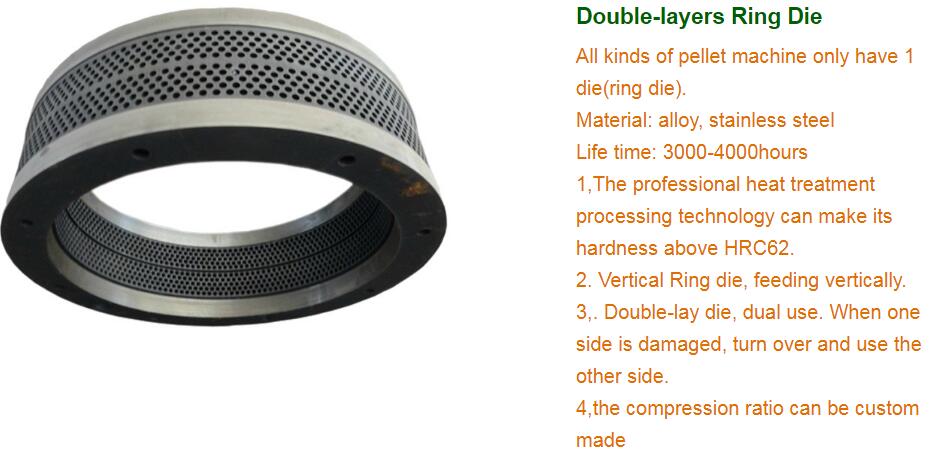Pellet machine in the process of use may encounter a variety of failures, the following are some common failures and their solutions:
1.Too low output (even no pellets)
Causes of faults:
Flat die or ring die problems: The flat die hole is poorly smooth when used for the first time, or the ring die has been used for a long time, the die hole is worn and blocked, affecting the extrusion of the material; for new flat dies, there may be insufficient running-in.

Material problems: The moisture content of the material is too high or too low. If the moisture content is too high, the material is easy to adhere to the mold and block the die hole; if the moisture content is too low, the fluidity of the material is poor and it is difficult to form.
Gap problem: The gap between the pressure roller and the flat die or ring die is too large, the material cannot be fully squeezed, resulting in reduced output; or the pressure roller is severely worn, and the fit with the mold becomes poor, which will also affect the output.
Power transmission problem: The V-belt (or other transmission parts) slips or ages, and the power transmission is insufficient, which causes the speed of the pellet machine to decrease, affecting the output.
Solution:
Mold treatment: For new flat dies, oil-containing materials can be used for grinding and lubrication. After a period of running-in, the output will gradually increase; for blocked die holes, the machine needs to be stopped for cleaning; if the die holes are severely worn and cannot be repaired, a new flat die or ring die should be replaced.
Adjust the moisture content of the material: According to the characteristics of the material and the requirements of the pellet machine, adjust the moisture content of the material to a suitable range. Generally speaking, the moisture content of the material is more suitable between 10% and 15%, but different materials may vary.
Adjust the gap: Adjust the gap between the pressure roller and the flat die or ring die to keep it within a suitable range. The size of the gap should be determined according to the model of the pellet machine and the characteristics of the material, generally between 0.1mm and 0.3mm.
Replace transmission parts: Check the tension of the V-belt (or other transmission parts). If it is loose, it should be adjusted or replaced in time; if the V-belt is aging and severely worn, a new V-belt should be replaced.
2.Too much powder in the granules
Cause of the fault:
Water problem: The moisture content of the material is too low, resulting in insufficient viscosity of the material, which cannot be well formed during the granulation process, resulting in too much powder in the granules.
Mold wear: Excessive wear of the flat die or ring die makes the granule forming effect worse, the granules are easy to break, and more powder is produced.
Solution:
Increase the moisture content: Add an appropriate amount of water to the material to increase the moisture content of the material, enhance the viscosity of the material, and reduce the powder content in the granules.
Replace the mold: If the flat die or ring die is severely worn, a new mold should be replaced in time to ensure the molding quality of the granules.
3.Rough surface of particles
Cause of failure:
Moisture problem: The moisture content of the material is too high. During the granulation process, the moisture cannot evaporate in time, resulting in moisture on the surface of the particles, which makes the surface of the particles rough.
Mold problem: The surface finish of the new mold is not smooth enough, or there are scratches, pits and other defects on the mold, which will also make the surface of the particles rough.
Solution:
Reduce the moisture content: Dry the material to reduce the moisture content of the material so that the moisture content meets the granulation requirements.
Mold treatment: For new molds, you can first grind them with oil-containing materials to improve the surface finish of the mold; if there are defects on the mold, it should be repaired or replaced in time.
4.Abnormal noise
Cause of the fault:
Foreign matter entering: During the production process, hard debris (such as iron blocks, stones, etc.) may enter the pellet machine and collide with the rotating parts, causing abnormal noise.
Bearing damage: Bearings are important parts of the pellet machine. If the bearings are worn, lack oil or damaged, the pellet machine will produce abnormal noise during operation.
Loose parts: During the long-term operation of the pellet machine, due to vibration and other reasons, some parts such as bolts and nuts may become loose. These loose parts will collide with each other during the operation of the pellet machine, causing noise.
5.Sudden shutdown
Cause of failure:
Overload: The feed volume is too large, or the material contains large hard objects, which causes the pellet machine to be overloaded and exceeds the motor's load capacity, thereby activating the motor overload protection device, causing the pellet machine to suddenly shut down; it may also be that the fuse is blown, causing the pellet machine to shut down due to power failure.
Foreign matter stuck in the machine: Foreign matter enters the interior of the pellet machine and gets stuck between the rotating parts, making the pellet machine unable to operate normally, resulting in a sudden shutdown.
6.The temperature rise of the spindle head is too high
Cause of the fault: The clearance of the spindle bearing is too small, the friction increases, and the temperature rises.
Solution: Loosen the clamping nut appropriately to increase the bearing clearance so that the spindle can run smoothly.





















